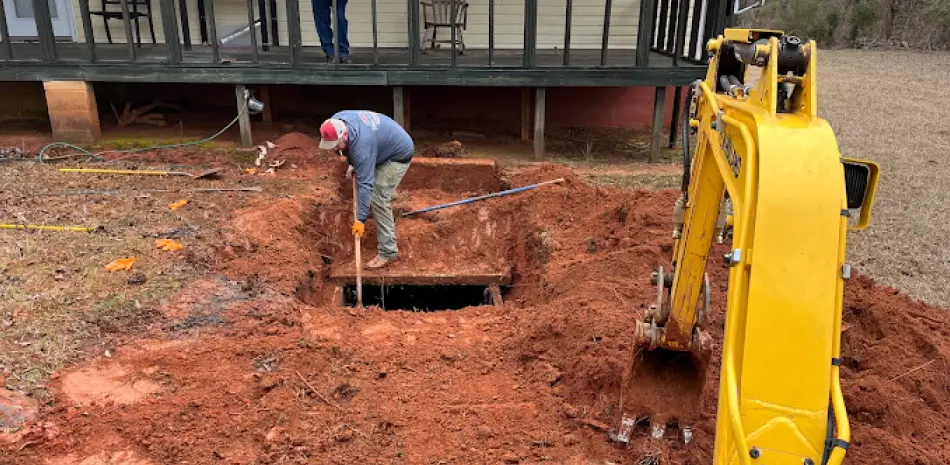How a Septic System Works (and Why You Should Care)
Understanding the basics of how your septic system works can help you manage it more effectively. A typical septic tank collects wastewater from your home—everything from toilets, sinks, showers, and laundry. Solids settle at the bottom, forming sludge, while grease and oils float to the top, forming scum. The liquid waste (known as effluent) flows into the drain field, where it gets naturally filtered by the soil.
Without proper maintenance, sludge and scum can build up, causing backups, foul smells, and even damage to your drain field. Once the drain field becomes saturated, your septic system can no longer process waste effectively, leading to costly repairs or replacements.
Top Tips for Septic System Maintenance
Schedule Regular Septic Tank Pumping
One of the most effective ways to maintain your septic system is by scheduling regular pumping. On average, most septic tanks need to be pumped every 3 to 5 years, depending on the size of the household and the tank’s capacity. A full tank can lead to sewage backup, which is not only a health hazard but also a major headache.
Pro Tip: Keep a log of your pumping schedule so you never forget when it’s due. If your household uses a garbage disposal frequently, consider pumping more often, as food waste can accelerate sludge buildup.
Use Water Wisely
Septic systems rely on a steady, manageable flow of water. Overloading the system with too much water in a short time can disrupt the natural separation process inside the tank. Spread out laundry loads throughout the week, and fix leaky faucets and toilets to avoid unnecessary strain on your system.
Quick Fact: A leaky toilet can waste up to 200 gallons of water per day, which puts excessive pressure on your septic system.
Watch What Goes Down the Drain
Septic systems are designed to handle wastewater and human waste—not chemicals, grease, or non-biodegradable items. Avoid flushing wipes, feminine hygiene products, or household chemicals, as they can clog pipes and disrupt the bacteria inside the tank that help break down waste.
Stick to septic-safe toilet paper and avoid pouring oils or grease down the sink. If you need to dispose of chemicals or medications, check with your local disposal center for safe alternatives.
Recognizing the Early Signs of Septic System Trouble
Even with regular maintenance, problems can sometimes arise. The key is to catch these issues early before they turn into expensive repairs. Here are some red flags to watch for:
Slow Draining Sinks and Toilets
If you notice sinks, showers, or toilets draining slower than usual, it could indicate a clog in the septic system or drain field.Foul Odors Inside or Outside Your Home
A properly functioning septic system should never emit bad smells. If you detect a sewage odor, it’s a sign that your tank is full or there’s an issue with your drain field.Standing Water Around the Drain Field
If you see puddles or soggy areas near the drain field, it means the system is struggling to absorb wastewater properly. This can lead to contamination and requires immediate attention.Sewage Backups
This is the most obvious and severe sign of septic failure. If sewage starts backing up into your home, call a professional immediately.The Benefits of Preventive Maintenance
Staying on top of septic maintenance offers more than just peace of mind. Here are some tangible benefits of keeping your system in good shape:
Avoid Expensive Repairs: Small investments in pumping and inspections can prevent larger, more expensive repairs down the road.
Extend the Lifespan of Your System: A well-maintained septic system can last 20 to 30 years or more, while neglected systems often fail within 10 to 15 years.
Protect Your Property Value: If you plan to sell your home, a properly maintained septic system will increase its market appeal and help you avoid potential complications during the sale.
Safeguard the Environment: A failing septic system can leak untreated wastewater into the soil and local water sources, causing contamination. Preventive maintenance protects both your property and the environment.
When to Call in the Experts
While many aspects of septic maintenance can be handled by homeowners, certain tasks require the expertise of a professional. It’s recommended to have your system inspected every 1 to 2 years by a certified septic service provider. Professionals can identify issues that might go unnoticed during routine inspections, such as drain field saturation or tank leaks.
Additionally, if you experience recurring problems like slow drains or bad odors, don’t wait. These could be symptoms of a more significant issue that needs immediate attention.
Final Thoughts
Maintaining your septic system doesn’t have to be a chore, but it does require consistency. With regular pumping, mindful water usage, and an eye on potential warning signs, you can keep your system running smoothly and avoid costly repairs. The key is to stay proactive. Small efforts today can save you thousands down the road.
If you're unsure where to start, our septic services team is here to help. Whether you need a routine tank inspection or you’re dealing with a stubborn clog, we’ve got you covered. Get in touch with us today to schedule your next maintenance appointment and keep your system in top shape!

